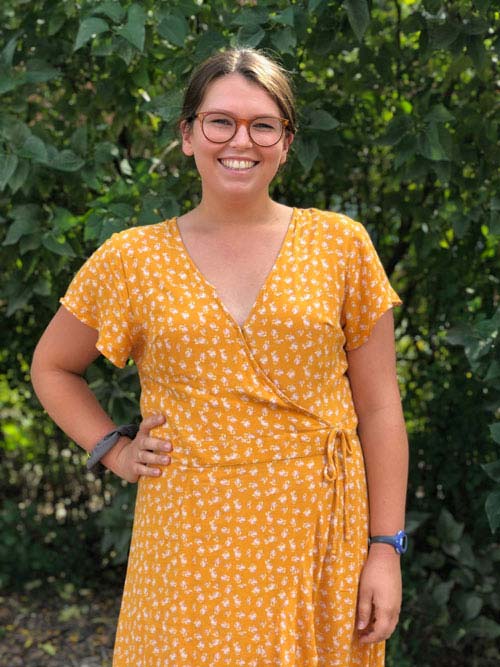Joint sustainability office to serve both the CSB and SJU campuses
October 19, 2020
By Mike Killeen

Rachel Brodeur
Double your workload, double the people you serve. Sounds like a tough assignment, right?
Not so, according to Rachel Brodeur, who heads the newly created joint sustainability office at the College of Saint Benedict and Saint John’s University.
“This is a big step,” said Brodeur, the sustainability coordinator of the two schools. “I think a lot of students are really proud to know that we’re an official department on both campuses.”
When Brodeur came to central Minnesota in 2019 following a year with the Minnesota GreenCorps in Lake County, Minnesota, she was hired to direct the CSB sustainability office. CSB has had a sustainability office with a full-time director for about 10 years.
SJU, meanwhile, used a fellowship strategy of recent graduates and students to staff its sustainability office during this period.
That changed over the summer, when Brodeur was asked to lead both areas by Sue Palmer and Dick Adamson, vice presidents for finance and administration at CSB and SJU, respectively.
“They reached out to me to see if I would be willing to take over a joint position of this nature,” Brodeur said. “I was super excited by it, and more than happy to do it because of the cohesion opportunities and just being more inclusive on both campuses.”
Brodeur said one of the advantages of creating a joint sustainability office was bringing “all the great things that are happening at both schools, and being able to share that with all students.
“It was really hard for me, working at Saint Ben’s, because it felt like we really could only cater to Bennies, or we could only really do events at Saint Ben’s. It was just this awkward thing,” said Brodeur, who received a bachelor’s degree in environmental studies from Luther College in 2018.
“Now, we’re really opening up this whole sustainability section of our campuses, to be able to do things at both places. There are so many great departments at Saint John’s, with environmental studies and Outdoor U, that we can build a better relationship and partnership with now,’” she said.
“I think that we will create a lot more robust programming within sustainability and being more widespread throughout both campuses,” Brodeur added.
There are a lot of ongoing old-school sustainability efforts going on at both schools because of their Benedictine roots.
“Right now, people are expecting really big, sexy, flashy sort of sustainability efforts, But if you really look deeply into where we are rooted, there’s a lot of cool things happening,” Brodeur said.
“At Saint John’s, they basically operate their own little city. They have their own (water) treatment plant, all the well systems and they create a lot of their own energy through steam and obviously the solar panels, too,” Brodeur said. “Looking back, they formed the brick for the Quad where (Clemens Stadium) is now.”
“I would say similarly at Saint Ben’s, we’re creating our own energy with the power plant on campus. The amount that we pay for square footage for energy from Xcel (Energy) is so low because we always produce so much of our own energy,” Brodeur said.
In addition, both campuses have been active planting vegetation native to prairie lands.
“These two campuses are probably some of the most sustainable infrastructures since the 1800s,” Brodeur said.
Brodeur’s office has two initiatives upcoming.
The first will bring reusable plastic containers to McGlynn’s at CSB during Block C, which beings Monday, Oct. 26. Every Bennie who wishes to be part of the program will receive a free token (faculty, staff or Johnnies can buy into the program for $5). Patrons will be able to exchange the token for food packaged in the reusable containers from items in the refrigerator or from the grill at the cafe.
 Customers will then rinse and clean the containers and bring them back to McGlynn’s, where they can repeat the process.
Customers will then rinse and clean the containers and bring them back to McGlynn’s, where they can repeat the process.
“We eliminate tons of used plastic,” Brodeur said. “The container is made of hard plastic that will be able to go through the dishwasher hundreds of times and not be a problem.”
The program began through a grant, which at the time was made to set up the pilot program at CSB. Long-range, however, it could conceivably come to Sexton Dining at SJU.
The other event is the Fall Week of Sustainability, which begins Monday, Oct. 26 on both campuses. The annual “Cut the Current” competition will be held during the week to see what dorm can reduce the most energy it uses.
“During that time, we will be having events at both campuses featuring a lot of partnerships throughout campus, like Campus Ministries, the Climate Justice Club and QPLUS,” Brodeur said.
